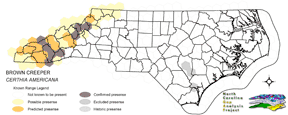
| Taxa: |
| Order: |
| Family: |
| Aves |
| Passeriformes |
| Certhiidae |
| NatureServe Global Rank: |
| NatureServe State (NC) Rank: |
| G5 |
| S3B,S5N |
| Federal Status: |
| NC State Status: |
| --- |
| W2,W5 |


| Land Unit |
| US Fish & Wildlife Service |
| US Forest Service |
| US National Park Service |
| US Department of Defense |
| NC State Parks |
| NC University System |
| NC Wildlife Res. Com. |
| NC Forest Service |
| NC Div. of Coastal Mgmt. |
| Local Governments |
| Non-Governmental Org. |
| Other Public Lands |
| Private Lands |
| GAP Status 1-2 |
| All Protected Lands |
| Statewide |
| Hectares |
| 0.00 |
| 9,508.41 |
| 0.00 |
| 12,442.77 |
| 451.08 |
| 1.26 |
| 48.33 |
| 0.00 |
| 0.00 |
| 567.54 |
| 1,111.68 |
| 0.00 |
| 8,258.49 |
| 15,945.03 |
| 24,122.52 |
| 32,389.56 |
| Acres |
| 0.00 |
| 23,495.79 |
| 0.00 |
| 30,746.75 |
| 1,114.64 |
| 3.11 |
| 119.43 |
| 0.00 |
| 0.00 |
| 1,402.42 |
| 2,747.02 |
| 0.00 |
| 20,407.17 |
| 39,401.02 |
| 59,608.03 |
| 80,036.33 |
| % of Dist. on |
| Prot. Lands |
| 0.0 % |
| 39.4 % |
| 0.0 % |
| 51.6 % |
| 1.9 % |
| < 0.1 % |
| 0.2 % |
| 0.0 % |
| 0.0 % |
| 4.6 % |
| 4.6 % |
| 0.0 % |
| 0.0 % |
| 66.1 % |
| ----- |
| ----- |
| % of Dist. on |
| All Lands |
| 0.0 % |
| 29.4 % |
| 0.0 % |
| 38.4 % |
| 1.4 % |
| < 0.1 % |
| 0.1 % |
| 0.0 % |
| 0.0 % |
| 1.8 % |
| 3.4 % |
| 0.0 % |
| 25.5 % |
| 49.2 % |
| ----- |
| ----- |
|
Breeds mostly in the high altitude forest of the mountains (Potter et al 1980), generally above 4,400 ft. (Simpson 1992). Breeds in mature forests, typically spruce and/or fir, or where spruce or fir are mixed with hardwoods (Hamel 1992). Occasionally breeds in hemlock or white pine forests (Hamel 1992, Simpson 1992). Forages on the trunk and limbs of trees (Kaufman 1996). Nest is commonly built behind bark scales (Potter et al 1980) or a loose piece (Hamel 1992) / large strip (Kaufman 1996) of bark still attached to the tree. Ehrlich et al (1988) describe it as a 'hammocklike cup.' Knotholes and natural cavities are also known as nest placement locations (Potter et al 1980). On average nest is usually 5 to 15 feet above the ground (Harrison 1975). Potter et al (1980) lists material such as moss, lichens, rootlets, grasses, spider cocoons, and shredded bark as material used for construction of the nest. Creepers forage up the bark of trees, starting at the base, searching the crevices for small insects, larvae, and insect eggs (Hamel 1992). NATURE SERVE GLOBAL HABITAT COMMENTS: Preferred habitat includes forest, woodlands, forested floodplains and swamps. Scrub and parks are also used in winter and during migration. Brown creepers are most often found in coniferous and mixed forests. A study by Franzreb (1985) describes the habitat in Arizona as mixed-coniferous forest, dominated by Douglas-fir, ponderosa pine and southwestern white pine. Within they're habitat, birds selected the largest (tallest) trees most often for foraging. Hejl (1992) reported finding larger numbers in western red cedar stands than in the Douglas-fir/ponderosa pine stands in 1992 field work. In the eastern U.S. south of the northern conifer zone, populations occur regularly in forested floodplains, and sometimes swamps. Hamas (1992), based on his experience, suggested that floodplain forests may be important habitat in Michigan. Davis (1978) studied populations in Michigan in two different forest types. One was an old white cedar, balsam fir, and black spruce swamp, with components of sugar maple, red maple, white pine, basswood and paper birch. The other was more topographically varied and drier; tree species included red maple, American beech, with less common white oak, eastern hemlock, large-toothed aspen, butternut hickory, and American elm. In the wetter areas of this site, dead American elms were common, and in the wettest areas, white cedar and eastern hemlock occurred. Davis (1978) found that all nests were in dead trees, and all nest trees were near water. Two were in swamps, while all others were within 60 m of flowing streams. A component of dead trees is essential for nesting, so brown creepers tend to be associated with older forests. Hejl and Woods (1991) found them in old growth forests (200+ yr), but never in rotation-aged (80 to 120 yr) Douglas- fir/ponderosa pine stands in western Montana and adjacent Idaho. The birds have also been known to move into areas where many trees have died due to flooding or disease (Bent 1964). Temporary positive impacts have been created by Dutch elm and other forest diseases, and by artificial floodings in forested areas. Both diseases and floodings leave standing dead wood and create large numbers of good nesting sites. However, the suitability of the habitat is, of course, only temporary in these situations. Brown creepers have been reported to become abundant in such situations (Bent 1964, Davis 1978, Nicholson 1992), suggesting a certain degree of opportunism. Forest, woodland, swamps; also scrub and parks in winter and migration. Negatively impacted by forest fragmentation in southern Wyoming (Keller and Anderson 1992). Nests usually behind loose slab of bark still attached to living or dead tree, average of 1.5-5 m above ground (Harrison 1979). |
| Code | Name | Description | NC Natural Heritage Program Equivalent |
| 521 | Spruce/Fir Forest | High Elevation Frazer-Fir - Red Spruce, Red Spruce and Red-Spruce-Yellow Birch Forests. Tree densities included here include both woodland to forest density. Highly intermixed with Northern Hardwoods, Grassy Balds, and Shrub Balds. | Red Spruce--Fraser Fir Forest, Fraser Fir Forest |
| 522 | Northern Hardwoods | High Elevation forests including yellow birch, American beech, and yellow buckeye. Includes forests with Hemlock and Yellow Birch. | Northern Hardwoods Forest, Boulderfield Forest |
| 527 | Appalachian Hemlock | Upland hemlock forests of the moutains region. Vary from side slopes to steep slope positions. | Canada Hemlock Forest |
|
Davis, C. M. 1978. A nesting study of the brown creeper. Living Bird 17:237-63.
Bent, A.C. 1948. Life histories of North American nuthatches, wrens, thrashers, and their allies. U.S. National Museum Bulletin 195. Washington, D.C. Hamel, P. B. 1992. The land manager's guide to the birds of the south. The Nature Conservancy, Chapel Hill, North Carolina. 367 pp + several appendices. Herkert, J. R., editor. 1992. Endangered and threatened species of Illinois:status and distribution. Vol. 2:Animals. Illinois Endangered Species Protection Board. iv + 142 pp. Simpson MB Jr. 1992. Birds of the Blue Ridge Mountains. Chapel Hill and London: University of North Carolina Press. Keller, M. E., and S. H. Anderson. 1992. Avian use of habitat configurations created by forest cutting in southeastern Wyoming. Condor 94:55-65. Kaufman K. 1996. Lives of North American Birds. Boston, New York: Houghton Mifflin Company. Harrison, H.H. 1975. A field guide to bird's nests in the U.S. east of the Mississippi River. Houghton Mifflin Company, Boston, Massachusetts. 257 p. Harrison, C. 1978. A field guide to the nests, eggs and nestlings of North American birds. Collins, Cleveland, Ohio. Harrison, H.H. 1979. A field guide to western birds' nests. Houghton Mifflin Company, Boston. 279 pp. Potter, E. F., J. F. Parnell, and R. P. Teulings. 1980. Birds of the Carolinas. Univ. North Carolina Press, Chapel Hill. 408 pp. Terres, J.K. 1980. The Audubon Society encyclopedia of North American birds. Alfred A. Knopf, New York. American Ornithologists' Union (AOU), Committee on Classification and Nomenclature. 1983. Check-list of North American Birds. Sixth Edition. American Ornithologists' Union, Allen Press, Inc., Lawrence, Kansas. Ehrlich, P.R., D.S. Dobkin, and D. Wheye. 1988. The birder's handbook:a field guide to the natural history of North American birds. Simon and Shuster, Inc., New York. xxx + 785 pp. Hejl, S. J. and R. E. Woods. 1991. Bird assemblages in old-growth and rotation-aged Douglas-fir/ponderosa pine stands in the northern Rocky Mountains:a preliminary assessment. In Baumgartner, D. M. and J. E. Lotan (eds.). Interior Douglas-fir:the species |
For more information please contact them at:
NC-GAP Analysis Project
Dept. of Zoology, NCSU
Campus Box 7617
Raleigh, NC 27695-7617
(919) 513-2853
www.basic.ncsu.edu/ncgap